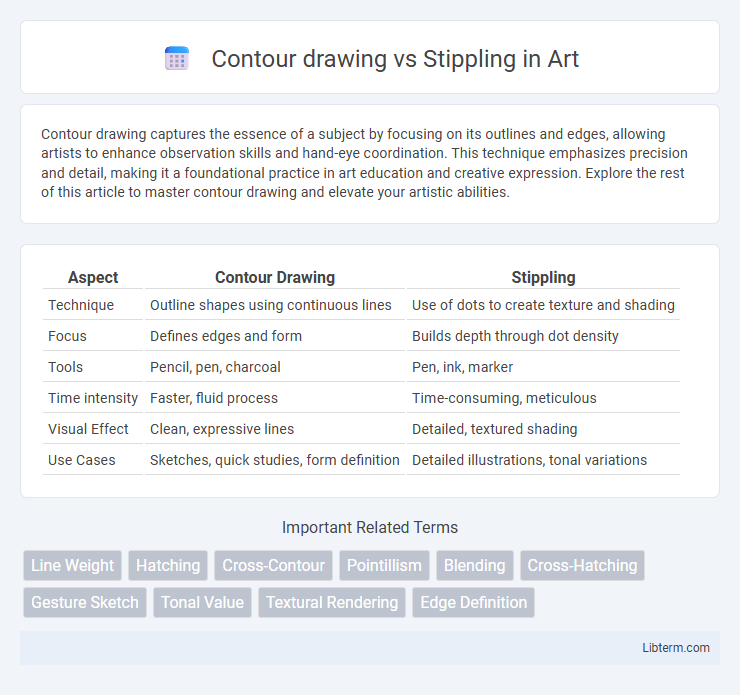Contour drawing captures the essence of a subject by focusing on its outlines and edges, allowing artists to enhance observation skills and hand-eye coordination. This technique emphasizes precision and detail, making it a foundational practice in art education and creative expression. Explore the rest of this article to master contour drawing and elevate your artistic abilities.
Table of Comparison
| Aspect | Contour Drawing | Stippling |
|---|---|---|
| Technique | Outline shapes using continuous lines | Use of dots to create texture and shading |
| Focus | Defines edges and form | Builds depth through dot density |
| Tools | Pencil, pen, charcoal | Pen, ink, marker |
| Time intensity | Faster, fluid process | Time-consuming, meticulous |
| Visual Effect | Clean, expressive lines | Detailed, textured shading |
| Use Cases | Sketches, quick studies, form definition | Detailed illustrations, tonal variations |
Introduction to Contour Drawing and Stippling
Contour drawing emphasizes capturing the outlines and significant details of a subject using continuous lines to define shapes and forms clearly. Stippling relies on creating images through the strategic placement of numerous small dots, varying density and spacing to convey texture, shading, and depth. Both techniques require keen observation skills, with contour drawing focusing on line precision and stippling emphasizing tonal variation through dot patterns.
Defining Contour Drawing
Contour drawing emphasizes capturing the outlines and edges of a subject to define its shape and form with continuous lines. This technique focuses on the precise observation of an object's boundaries rather than shading or texture. Contour drawing contrasts with stippling, which uses dots to create value and texture through varying densities.
What is Stippling Technique?
Stippling is a drawing technique that uses numerous small dots to create texture, shading, and depth by varying the density and distribution of the marks. Unlike contour drawing, which emphasizes continuous lines to define shape and form, stippling relies on pointillism to build up tonal values and intricate details. This method requires precise control and patience, making it ideal for achieving highly detailed and realistic artwork.
Tools and Materials for Each Technique
Contour drawing primarily requires smooth, fine-tipped pens or pencils such as graphite or ink for precise line control and fluidity. Stippling uses materials like fine point pens, technical pens, or micron markers to create countless small dots, demanding consistency and durability in the tip for detailed shading. Both techniques benefit from high-quality, acid-free paper with a smooth surface to support intricate line work and precise dot placement.
Different Approaches to Line and Texture
Contour drawing emphasizes continuous lines that define the edges and shapes of subjects, creating a smooth and fluid representation focused on form and outline. Stippling utilizes countless tiny dots to build texture and tonal variation, producing detailed gradients and depth through density and spacing rather than continuous lines. The contrast between contour drawing's linear clarity and stippling's pointillistic texture highlights distinct artistic methods for depicting volume and surface complexity.
Visual Effects: Bold Outlines vs. Subtle Shading
Contour drawing emphasizes bold outlines that define the shape and structure of objects with clear, continuous lines, creating a strong visual impact and precise form. Stippling, on the other hand, relies on subtle shading through numerous small dots to build texture and depth, producing a softer, more nuanced tonal variation. The visual effect of contour drawing highlights edges and boundaries, while stippling enhances dimensionality and gradation within the image.
Time Investment and Level of Detail
Contour drawing emphasizes capturing the essential outlines and forms with continuous lines, making it a faster technique requiring less time investment compared to stippling. Stippling involves creating images through countless tiny dots, which demands significant time and patience but achieves a high level of intricate detail and texture. Artists often choose contour drawing for quick, expressive sketches, while stippling suits works needing meticulous precision and depth.
Suitable Subjects for Contour Drawing and Stippling
Contour drawing suits subjects with distinct shapes and clear edges, such as architectural forms, plants, and human figures, where line definition captures the object's structure. Stippling excels with subjects that benefit from detailed texture and subtle shading, like portraits, animal fur, and natural landscapes, using dot density to convey depth and tone. Choosing between contour drawing and stippling depends on whether the emphasis is on sharp outlines or gradual tonal variation.
Advantages and Challenges of Each Method
Contour drawing offers the advantage of capturing the essential shape and structure of a subject with fluid, continuous lines, making it ideal for quick sketches and studies of form. Challenges include difficulty in conveying depth and texture solely through line work, requiring practiced hand-eye coordination to maintain consistent flow. Stippling excels in creating rich tonal variation and texture by using numerous small dots, allowing for precise control over shading and depth, but it is time-consuming and demands patience and meticulous attention to detail.
Choosing the Right Technique for Your Artwork
Contour drawing emphasizes capturing the outlines and essential shapes of a subject, making it ideal for artists aiming to enhance their observational skills and streamline forms. Stippling involves creating texture and tonal variations through precise dot placement, perfect for detailed, high-contrast pieces requiring depth and subtle shading. Choosing between contour drawing and stippling depends on the desired level of detail, texture, and artistic expression within your artwork.
Contour drawing Infographic

 libterm.com
libterm.com